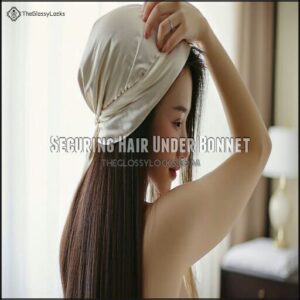This site is supported by our readers. We may earn a commission, at no cost to you, if you purchase through links.
 You can absolutely wear a bonnet with straight Caucasian hair.
You can absolutely wear a bonnet with straight Caucasian hair.
It’s a smart way to protect your hair from breakage, reduce frizz, and preserve your style overnight.
Look for bonnets made from silk or satin—these materials minimize friction and help keep your hair smooth.
Whether your hair’s long, short, or somewhere in between, you can gather it loosely or braid it before tucking it under the bonnet to avoid kinks or tangles.
While it might feel new at first, adding a bonnet to your routine could be the unsung hero of your hair care.
Who doesn’t want a little extra shine?
Table Of Contents
- Key Takeaways
- Should I Wear a Bonnet?
- Choosing The Right Bonnet
- Preparing Hair Before Bonnet
- Putting on The Bonnet
- Securing Hair Under Bonnet
- Benefits of Wearing a Bonnet
- Potential Drawbacks
- Frequently Asked Questions (FAQs)
- Are sleep bonnets good for Caucasian hair?
- Do you put all your hair in a bonnet?
- Does a bonnet protect all hair types?
- Is it necessary to wear a bonnet?
- Can a bonnet be used to style my hair?
- How often should I wash my bonnet?
- What are the best materials to look for when choosing a bonnet?
- Can a bonnet prevent hair damage outdoors?
- Are certain bonnet designs better for sports?
- How do bonnets impact scalp health?
- Conclusion
Key Takeaways
- You can wear a bonnet with straight Caucasian hair to reduce frizz, prevent breakage, and preserve your style overnight.
- Choose a silk or satin bonnet for minimal friction, better moisture retention, and smoother hair.
- Prep your hair by conditioning, detangling, and loosely braiding or gathering it before putting on the bonnet.
- A properly fitted bonnet ensures all your hair stays protected, reduces tangling, and keeps your style intact while you sleep.
Should I Wear a Bonnet?
Absolutely, wearing a bonnet with straight Caucasian hair is both beneficial and practical. Your hair type shouldn’t be a barrier to enjoying the protective benefits bonnets offer.
Despite common misconceptions that bonnets are only for curly textures, they’re excellent for all hair types, including straight hair. Consider your lifestyle factors when deciding: Do you wake up with bedhead? Is your climate dry? Does your hair tangle easily?
Bonnets aren’t just for curls—straight hair thrives with less frizz, tangles, and breakage while you sleep.
These questions help determine if a bonnet is right for you. Bonnets provide essential hair protection while sleeping by reducing friction against pillowcases, which helps prevent breakage and split ends.
The silk bonnet benefits are particularly notable—they maintain natural oils and moisture that straight hair often lacks. Wearing tight head coverings may lead to traction alopecia issues, so a bonnet’s looser fit is preferable.
Personal preference matters too. Some find the maintenance effort minimal compared to the payoff: smoother mornings with less styling time and healthier hair over time.
Choosing The Right Bonnet
You’ll need to take into account the material, size, and style when selecting a bonnet that works best for your straight hair type.
Silk and satin options will protect your strands from friction and moisture loss while you sleep.
But make sure you’ve measured your head properly for a comfortable fit that won’t slip off during the night, ensuring a comfortable wear.
Material
Now that you’ve decided to try a bonnet, choosing the right material is your key to success with straight Caucasian hair.
Silk vs satin bonnets is more than just a preference—it’s about what works for your hair type.
Both materials offer:
- Minimal friction that prevents overnight frizz
- Breathability that keeps your scalp comfortable
- Smooth texture that maintains your hair’s natural oils
Synthetic alternatives exist, but natural fabrics provide better durability concerns. You can explore options for the best bonnet material.
Size
Finding the right bonnet size can make or break your hair protection strategy.
Start by measuring your head circumference with a flexible tape measure and compare it to size charts before purchasing.
For straight Caucasian hair, you’ll typically need less volume than those with curly textures.
A bonnet size guide can further assist in selection.
Look for bonnets with adjustable straps that allow you to customize the tightness—snug enough to stay put overnight without causing headaches or tugging at your roots, which is crucial for effective hair protection.
Style
The rainbow of bonnet options available today means there’s a perfect style for your straight Caucasian hair.
From elegant satin classics to trendy patterns that complement your outfit pairing, bonnet fashion has evolved beyond basic.
When accessorizing bonnets, consider color choices that match your pajamas or bedroom decor.
Pattern matching isn’t just stylish—it’s functional too.
Adjustable bands provide customizable comfort, while designs with wider edges help keep straight hair care simple by preventing flyaways from escaping during sleep, which is a key aspect of straight hair care.
Preparing Hair Before Bonnet
You’ll want to make sure your straight hair is properly conditioned and detangled before putting on your bonnet, as this prevents overnight friction and breakage.
For maximum protection, you can also loosely braid your hair or twist it into a gentle bun to keep strands organized while you sleep.
Conditioning
Properly conditioning your straight Caucasian hair before bonnet wear transforms your overnight protection into a deep treatment session. Apply a quarter-sized amount of leave-in conditioner to damp hair, focusing on ends where straight hair typically experiences the most dryness.
For maximum hair hydration benefits:
- Use lightweight oil treatments (argan or jojoba) on mid-lengths to ends
- Balance protein and moisture with specialized conditioners for straight hair
- Apply deep conditioning mask weekly for 20 minutes before rinsing
- Distribute product with a wide-tooth comb for even coverage
- Pat (don’t rub) excess product before securing in your bonnet
This hydration method guarantees your straight hair maintains essential moisture while preventing product buildup, ensuring a healthy and properly conditioned hair care routine.
Braiding
After conditioning, braiding your straight Caucasian hair creates the perfect foundation for bonnet wear.
Twist your hair into a loose bun high on your head or create simple braids to prevent tangling and breakage while you sleep.
Some people use a sock over their ends before twisting to avoid kinking.
This simple hair protection technique maximizes your bonnet’s benefits and extends your hairstyle’s longevity.
Putting on The Bonnet
Now that your hair is properly prepped, let’s master the art of putting on your bonnet. With straight Caucasian hair, proper bonnet placement is key to ensuring maximum protection while sleeping.
Start by stretching the bonnet open with both hands and placing it over your head with the elastic band positioned at the back of your neck. Pull the elastic adjustment forward toward your hairline, ensuring bonnet tightness is comfortable but secure.
To further protect your hair, consider a pre-shampoo treatment before washing. This step can enhance the overall hair protection and make your hair care routine more effective.
Here’s why proper bonnet application matters:
- Your silk bonnet becomes a protective cocoon for your precious strands
- You’ll wake up looking like you just left the salon, not like you wrestled your pillow
- Hairstyle preservation becomes effortless, saving you morning styling time
- The right bonnet fit feels like a gentle hug for your hair
- Tucking ends properly prevents those annoying morning flyaways
Securing Hair Under Bonnet
You’ll need to properly secure your straight hair under the bonnet to prevent strands from slipping out during sleep or daily activities.
Tucking all your hair inside and using the elastic band strategically will guarantee your bonnet stays in place, protecting your hair from friction and helping maintain its natural oils throughout the night, which is crucial for keeping your hair healthy and naturally beautiful.
Gathering Hair
Now that your bonnet is ready, let’s tackle how to gather your straight Caucasian hair properly.
Start by using the pineapple method—gather all your hair at the crown of your head. For longer locks, try hair folding or twisting techniques to create a compact bundle.
One method involves using silk or satin pillowcases to reduce friction.
When tucking ends, make certain every strand is secured inside the bonnet to maximize overnight protection and prevent hair breakage while sleeping.
Clips and Pins
While gathering your hair helps, sometimes those flyaways need extra attention.
Strategic clip placement can make all the difference:
- Bobby pins work best for shorter layers, placed flat against the scalp
- Flat clips secure side sections without creating uncomfortable pressure points
- Silk-covered pins prevent damage to straight Caucasian hair while ensuring a secure hold
Consider various bobby pin options for ideal hold.
You’ll wake with protected, tangle-free straight hair that maintains its natural shine overnight.
Benefits of Wearing a Bonnet
Waking up with sleek, smooth hair feels amazing, doesn’t it? A satin bonnet for straight Caucasian hair offers just that by reducing frizz and keeping your style intact.
A satin bonnet effortlessly keeps your hair sleek, frizz-free, and styled, so you wake up feeling polished and ready to go.
It works wonders for hair protection while sleeping, forming a gentle barrier that prevents knots, tangles, and breakage. Plus, the fabric promotes Moisture Retention, locking in those nourishing oils and deep conditioners you applied before bed.
Hair bonnet benefits go beyond looks—it supports Scalp Health by reducing friction, which often causes irritation. You’ll notice fewer flyaways, a polished appearance, and healthier strands over time.
Just remember, let your hair dry before slipping on the bonnet to avoid dampness, ensuring a fresh start every morning with protected, preserved locks, and enjoying the benefits of sleek, smooth hair and reduced frizz for a more polished appearance.
Potential Drawbacks
While bonnets can be helpful, they’re not without a few hiccups. You might notice issues like added heat or limited styling options, depending on how you use them.
Heat Buildup
Nobody wants to wake up sweaty from scalp perspiration, right?
Overheating in a bonnet can sometimes feel like too much of a good thing, especially with straight Caucasian hair.
To boost air circulation and combat heat buildup, stick to silk or satin bonnets with material breathability.
These overheating solutions help maintain hair health while still offering high-quality hair protection while sleeping.
Limits Styling
Using a bonnet for straight hair can bring unexpected style limitations overnight.
While it protects against breakage, you might notice texture alteration or some volume reduction. Extra-room bonnets help reduce matting, but hairstyle retention isn’t guaranteed.
Straight Caucasian hair may flatten slightly—embrace textured waves by trying dry shampoo or sprays before styling options bring your look back to life.
The shape of hair follicles, influenced by genetics, determines straight or curly hair, which can result in straight or curly hair.
Frequently Asked Questions (FAQs)
Are sleep bonnets good for Caucasian hair?
An ounce of prevention is worth a pound of cure!
Sleep bonnets work wonders for Caucasian hair, minimizing frizz, locking in moisture, and preventing breakage.
They’re especially helpful with straight hair, keeping it smooth overnight, and are a great tool for preventing breakage.
Do you put all your hair in a bonnet?
Yes, you can tuck all your hair into a bonnet, especially for protection and reduced frizz.
Just gather your hair gently, flip it forward, and secure the bonnet snugly to keep it in place.
Does a bonnet protect all hair types?
It’s funny how bonnets work for everyone—straight, curly, or coily hair.
They shield your strands from breakage, dryness, and frizz, keeping styles intact.
Whether your hair’s sleek or textured, bonnets are a universal protector!
Is it necessary to wear a bonnet?
It’s not absolutely necessary to wear a bonnet, but it can make a big difference for your hair’s health.
It protects against frizz, breakage, and dryness, keeping your hair looking smooth and moisturized.
Can a bonnet be used to style my hair?
You can use a bonnet to protect your hairstyle overnight or while lounging.
It minimizes frizz, locks in moisture, and prevents breakage.
Plus, it helps preserve styling techniques like curls or sleek straight looks. **
How often should I wash my bonnet?
A clean bonnet is a happy bonnet.
Wash yours every one to two weeks, depending on usage.
If you apply heavy hair products often, aim for weekly washes to keep it fresh and hygienic.
What are the best materials to look for when choosing a bonnet?
Look for bonnets made of silk or satin.
These materials reduce friction, prevent dryness, and help lock in moisture.
They’re especially great for protecting your hair while you sleep, keeping it smooth and manageable.
Can a bonnet prevent hair damage outdoors?
Wearing a bonnet outdoors is like giving your hair its personal bodyguard.
It shields strands from sun, wind, and dirt, reducing breakage and dryness.
Choose silk or satin for maximum protection and style points.
Are certain bonnet designs better for sports?
For sports, pick a snug bonnet with adjustable straps or an elastic band to stay secure.
Sweat-wicking materials like silk-blends help keep you comfortable while protecting your hair from friction and breakage.
How do bonnets impact scalp health?
Think of a bonnet as your scalp’s kind-hearted bodyguard.
It reduces friction, keeps natural oils intact, and prevents dryness or irritation.
You’ll enjoy a healthier, balanced scalp that feels nurtured and less stressed.
Conclusion
Using a bonnet with straight Caucasian hair is like giving your hair a cozy, protective hug.
It’s an easy way to keep your style intact, prevent breakage, and reduce unwanted frizz overnight.
Choose a satin or silk bonnet that fits well and feels comfortable, and prep your hair with simple techniques like loose gathering or braiding.
With time, you’ll see smoother, healthier locks.
So, can you wear a bonnet with straight Caucasian hair? Absolutely—your hair will thank you, and it’s a great way to give your hair a protective hug.










